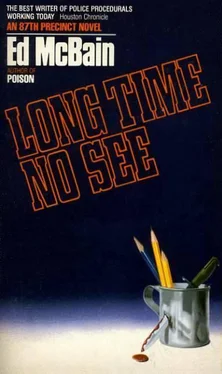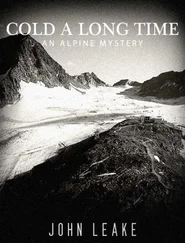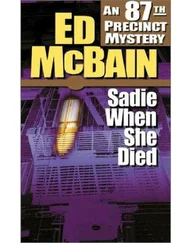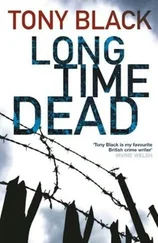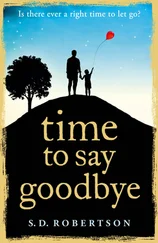“Well,” Carella said.
“What do you think, Steve?”
“I don’t know,” Carella said. He was thinking he was cold. He was thinking this was very goddamn cold for November. He was thinking back to the year before when the city became conditioned to expect only two different kinds of weather all winter long. You either woke up to a raging blizzard, or you woke up to clear skies with the temperature just above zero. That was the choice. He was not looking forward to the same choice this year. He was thinking he wouldn’t mind living in Florida or California. He was wondering if any of the cities down there in Florida could use an experienced cop. Track down a couple of redneck bank robbers, something like that. Sit in the shade of a palm tree, sip a long frosty drink. The thought made him shiver.
The Harris building seemed more welcoming in broad daylight than it had the night before. There was grime on its facade, to be sure — this wouldn’t be the city without grime — but the red brick showed through nonetheless, and the building looked somehow cozy in the bright sunlight. That was something people forgot about this city. Even Carella usually thought of it as a place tinted in various shades of black and white. Soot-covered tenements reaching into gray sky above, black asphalt streets, gray sidewalks and curbs, a monochromatic metropolis, ominous in its gloom. But the absolute opposite was true.
There was color in the buildings — red brick beside yellow, brownstone beside wood painted orange or blue, swirled marble, orange cinder block, pink stucco. There was color in the billboard posters — overlapping and blending and clashing so that a wall of them advertising attractions varying from a rock concert to a massage parlor achieved the dimension of an abstract painting. There was color in the traffic and the traffic lights — reds, yellows and greens flashing on rain-slick pavements reflecting the metallic glow of Detroit’s fancy, every color in the spectrum massed here in these crowded streets to create a moving mosaic. There was color in the debris — this city had more garbage than any other in the United States, and more often than not it went uncollected because of yet another garbage strike. It lay in plastic bags against the walls of apartment buildings, the greens, beiges and pale yellows of modern technology enclosing the waste product of a city of eight million — or tom open by rats to spill in putrefying hues upon the sidewalks. There was color, too — God help the subway rider — in the graffiti that was spray-can-painted onto the sides of the shining new mass transit cars. Latin curlicues advertising this or that macho male, redundant, but then, so was spraying your name fourteen times on as many subway cars. And lastly, there was color in the people. No simple blacks or whites here. No. There were as many different complexions as there were citizens.
Both men were silent as they climbed the steps to the entrance lobby. One of them was thinking about seasons, and the other was thinking about colors. Both were thinking about the city. They climbed the steps to the third floor and knocked on the door to apartment 3C. Carella looked at his watch, and knocked again.
“Did you tell her ten o’clock?” Meyer asked.
“Yes.” Carella knocked again. “Mrs. Harris?” he called. No answer. He knocked again, and put his ear to the door. He could hear nothing inside the apartment. He looked at Meyer.
“What do you think?” Meyer said.
“Let’s get the super,” Carella said.
They went downstairs again, found the super’s apartment where most of them were, on the ground-floor landing at the end of the stairwell hall. He was a black man named Henry Reynolds, said he’d been superintendant here for six years, knew the Harrises well. Apparently, he did not yet know that Jimmy Harris had been slain last night. He talked incessantly as they climbed the steps again to the third floor, but he did not mention what he would most certainly have considered a tragedy had he known of it, nor did he ask why the police wanted access to the apartment. Neither Meyer nor Carella considered this strange. Often, in this city, the citizens did not ask questions. They knew cops only too well, and it was usually simpler to go along and not make waves. Reynolds knocked on the door to apartment 3C, listened for a moment with his head cocked toward the door, shrugged, and then unlocked the door with a passkey.
Isabel Cartwright Harris lay on the floor near the refrigerator.
Her throat had been slit, her head was twisted at an awkward angle in a pool of her own blood. The refrigerator door was open. Crisping trays and meat trays had been pulled from it, their contents dumped onto the floor. There were open canisters and boxes strewn everywhere. Underfoot, the floor was a gummy mess of blood and flour, sugar and cornflakes, ground coffee and crumpled bisquits, lettuce leaves and broken eggs. Drawers had been overturned, forks, knives and spoons piled haphazardly in a junk-heap jumble, paper napkins, spaghetti tongs, a corkscrew, a cheese grater, place mats, candles all thrown on the floor together with the drawers that had contained them.
“Jesus,” Reynolds said.
The body was removed by twelve noon. The laboratory boys were finished with the place by two, and that was when they turned it over to Meyer and Carella. The rest of the apartment was in a state of disorder as violent as what they had found in the kitchen. Cushions had been removed from the sofa and slashed open, the stuffing pulled out and thrown onto the floor. The sofa and all the upholstered chairs in the room had been overturned, their bottoms and backs slashed open. There was only one lamp in the living room, but it was resting on its side, and the shade had been removed and thrown to another comer of the room. In the bedroom, the bed had been stripped, the mattress slashed, the stuffing pulled from it. Dresser drawers had been pulled out and overturned, slips and panties, bras and sweaters, gloves and handkerchiefs, socks and undershorts, T-shirts and dress shirts scattered all over the floor. Clothing had been pulled from hangers in the closet, hurled into the room to land on the dresser and the floor. The closet itself had been thoroughly ransacked — shoe boxes opened and searched, the inner soles of shoes slashed; the contents of a tackle box spilled onto the floor; the oilcloth covering on the closet shelf ripped free of the thumbtacks holding it down. It seemed evident, if not obvious, that someone had been looking for something. Moreover, the frenzy of the search seemed to indicate he’d been certain he would find it here.
Carella and Meyer had no such definite goal in mind, no specific thing they were looking for. They were hoping only for the faintest clue to what had happened. Two people had been brutally murdered, possibly within hours of each other. The first murder could have been chalked off as a street killing; there were plenty of those in this fair city, and street killings did not need motivation. But the second murder made everything seem suddenly methodical rather than senseless. A man and his wife killed within the same twenty-four-hour period, in the identical manner, demanded reasonable explanation. The detectives were asking why. They were looking for anything that might tell them why.
They were hampered in that both the victims were blind. They found none of the address books they might have found in the apartment of a sighted victim, no calendar jottings, no shopping lists or notes. Whatever correspondence they found had been punched out in Braille. They collected this for translation downtown, but it told them nothing immediately. There was an old standard typewriter in the apartment; it had already been dusted for prints by the lab technicians, and neither Carella nor Meyer could see what other information might be garnered from it. They found a bank passbook for the local branch of First Federal on Yates Avenue. The Harrises had two hundred and twelve dollars in their joint account. They found a photograph album covered with dust. It had obviously not been opened in years. It contained pictures of Jimmy Harris as a boy and a young man. Most of the people in the album were black. Even the pictures of Jimmy in uniform were mostly posed with black soldiers. Toward the end of the album was an eight-by-ten glossy photograph.
Читать дальше
